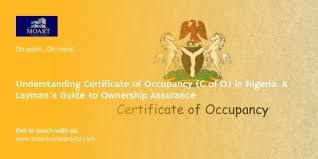The Complete Guide to Certificate of Occupancy in Nigeria

Understanding the Certificate of Occupancy (C of O) in Nigeria: A Comprehensive Guide
A Certificate of Occupancy (C of O) is a crucial document in Nigeria’s land ownership framework. It legally confirms property ownership, safeguarding landowners from disputes and potential claims. This guide explains its significance, costs, and the processes involved in obtaining one.
What is a Certificate of Occupancy?
The Certificate of Occupancy (C of O) is a government-issued legal document granting individuals or entities the right to occupy and use a specific parcel of land for a designated period, typically 99 years. It provides:
- Proof of Ownership: Establishes lawful claim to a property.
- Protection Against Claims: Prevents unlawful disputes.
- Compliance with Law: Aligns with the Land Use Act of 1978, which regulates land ownership in Nigeria.
Unlike informal land claims, a C of O serves as an official recognition of ownership, granting the holder undisputed legal authority.
Importance of a Certificate of Occupancy in Nigeria
1. Protection of Ownership Rights
A C of O solidifies ownership and prevents unauthorized claims.
2. Prevention of Legal Disputes
With a recognized document, landowners minimize the risk of conflicts or disputes.
3. Financial and Investment Opportunities
Banks and investors often require a C of O as proof of ownership before approving loans or partnerships.
Steps to Obtain a Certificate of Occupancy in Nigeria
Application Process
- Visit your state’s land bureau and obtain an application form.
- Submit the completed form along with necessary documents such as:
- A survey plan of the land.
- Evidence of ownership or purchase.
- Passport photographs.
- Pay the prescribed application fees.
- Allow land officers to inspect and verify the property.
- Upon approval, receive the Certificate of Occupancy.
Required Documents
- A detailed survey plan.
- Proof of land ownership or purchase.
- Completed application form.
- Payment receipts for associated fees.
Timeline
The process typically takes between three months to a year, depending on the state and the efficiency of its land bureau.
Cost of Obtaining a Certificate of Occupancy
Government Fees and Related Expenses
Costs vary by state, influenced by factors such as land size and location. For example:
- In Lagos State, fees for residential lands range between ₦100,000 and ₦300,000.
Hidden Costs
- Survey fees.
- Legal fees.
- Land registration costs.
Clarify all expenses upfront to avoid surprises.
Challenges in Securing a Certificate of Occupancy
1. Bureaucratic Delays
Lengthy processing times can be frustrating. To mitigate delays, ensure all documentation is accurate and complete.
2. Common Mistakes
Errors in survey plans or incomplete forms are frequent causes of rejection. Engage experienced professionals for guidance.
Overcoming Challenges
- Hire experts for proper documentation and representation.
- Regularly follow up with the land bureau.
- Understand state-specific requirements.
Benefits of a Certificate of Occupancy
Owning a C of O enhances property value, provides legal security, and unlocks opportunities for financial transactions and investments.
Verifying the Authenticity of a Certificate of Occupancy
Steps for Verification
- Visit the land bureau in the issuing state.
- Conduct a search to confirm registration details.
- Cross-check the serial number with official records.
Red Flags
Be cautious of inconsistencies in names, survey numbers, or missing government stamps, which could indicate fraud.
FAQs About the Certificate of Occupancy
1. What is the difference between a Certificate of Occupancy and a Deed of Assignment?
- A Certificate of Occupancy is issued by the government, while a Deed of Assignment transfers ownership between private parties.
2. How long does it take to obtain a C of O in Lagos?
- The process typically takes three months to a year, depending on accuracy and efficiency.
3. Can I apply for a C of O for ancestral land?
- Yes, with proof of ownership, such as a family agreement or legal title.
4. Are Certificates of Occupancy transferable?
- Yes, but transfer requires government approval and proper documentation.
5. What if my C of O expires?
- You must renew it by reapplying and paying renewal fees.
6. Is a C of O necessary for small residential plots?
- Yes, it protects ownership rights and ensures legal compliance.
Conclusion
A Certificate of Occupancy is essential for landowners in Nigeria. It secures ownership, prevents disputes, and enhances financial opportunities. While the process can be complex, understanding the steps and seeking professional guidance simplifies it.
For further details, explore our guide on the differences between R of O and C of O.







